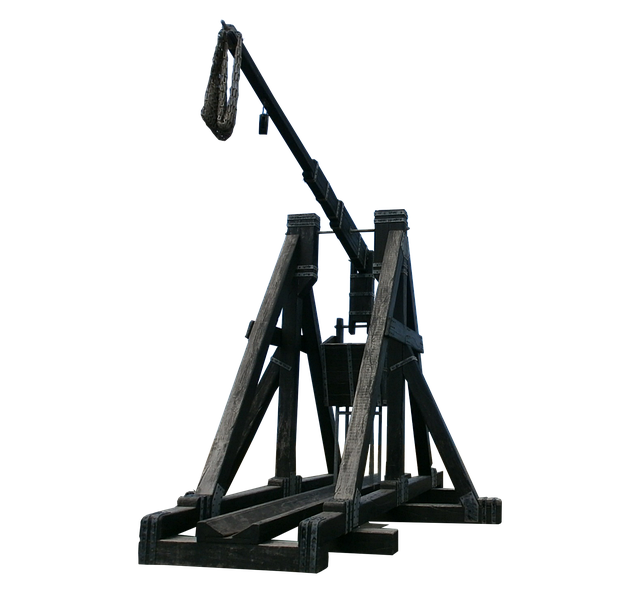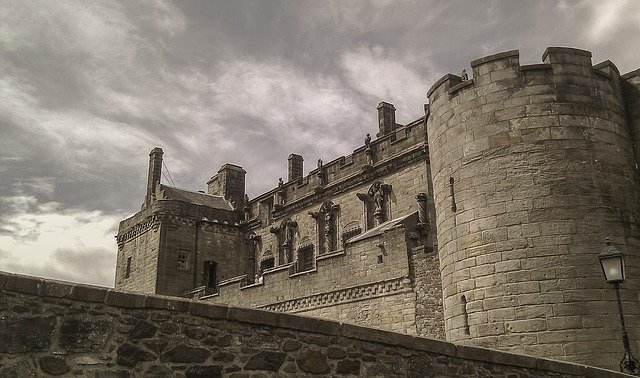By Tim Lambert
Many castles were built in Europe in the Middle Ages. Of course, the idea of a fort goes back to prehistoric times. However, a castle was also a residence for a king, a noble, or a bishop. However each noble usually owned more than one castle and spent some time travelling between his castles with the members of his household.
The great age of castle building in England began with the Normans. When they conquered the Saxons in 1066 they needed forts to hold down the native Saxon population. The Normans built wooden forts called motte and bailey castles. An artificial mound of earth was created, called a motte and the living quarters were built on top. Below was a walled yard called a bailey where food and animals were stored. The whole thing was sometimes protected by a moat. The Anglo-Saxon Chronicle (a kind of national diary) said ‘He (William the Conqueror) caused castles to be made and poor men to be greatly oppressed’.
However, these early wooden forts were vulnerable to fire, and later castles in England were built of stone. The most famous is the Tower of London. However many more stone castles were erected during a civil war from 1135 to 1154. A monk wrote: ‘They filled the whole land with these castles. They sorely burdened the unhappy people of the country with forced labor on the castles’. n In the center of a castle was a stone tower called a keep where the inhabitants lived. Surrounding it was a curtain wall. However, even if attackers breached the curtain wall the defenders could retreat into the keep and continue to hold out.
The weakest part of a castle was its gate but there were ways of strengthening it. A building called a gatehouse was built. Often it was approached by a drawbridge over a moat. Gatehouses usually had an iron grid called a portcullis that could be raised or lowered vertically. Behind the portcullis was a covered passageway running through the gatehouse. Sometimes there was a second portcullis at the other end of the passageway. (Portcullis is derived from the Old French words port coleice, which meant sliding door).
Some gates in Medieval castles (and town walls) were strengthened by a barbican (an outer tower or pair of towers standing in front of the gate). The place-name Barbican still exists in some places in England where one once stood. If you got past the drawbridge and the first portcullis you would have to fight your way to the second portcullis and the defenders would not make it easy for you.
In the roof of the gatehouse, there were often holes through which the defenders could drop stones or pour boiling liquids. Around the curtain wall of a castle were arrow slits called embrasures. Furthermore, the tops of the castle walls often had overhangs. In them were openings through which boiling liquids could be poured or stones could be dropped. They were called machicolations. If you tried to cross the moat people could drop things on you through the machicolations.
Siege Weapons
However, attackers could use a variety of siege weapons. The simplest was a battering ram. The users were protected by a wooden shed but the defenders might set it on fire. They could also use a crane with giant ‘tongs’ to try and grab the ram.
To climb the walls of a Medieval castle you could use ladders but that was dangerous as the defenders could push them over. Attackers might use a wooden siege tower on wheels. Inside it were ladders for soldiers to climb. At the top was a drawbridge. When it was lowered the attackers could swarm over the castle walls. Attackers could also use a kind of crane called a tenelon to get over the wall. On the end of a long wooden arm was a basket containing soldiers. The basket could be swung over the castle walls. The attackers could also hurl missiles. A Medieval catapult was powered by twisted rope. The rope was twisted tighter and tighter then released, firing a stone.
Another Medieval siege weapon was called a trebuchet. It worked by counterweight. It was a kind of see-saw with a huge weight at one end and a sling containing a missile at the other. The sling was tied down and when it was released the great weight at the other end of the ‘see-saw’ caused it to swing upwards and hurl its missile.

Attackers could also tunnel under the castle walls. The tunnels were supported by wooden props. When ready they were covered in animal fat and burned. The tunnels would collapse and hopefully so would the walls.
Life in a Castle
In Saxon England, a rich man and his entire household lived together in one great hall. In the Middle Ages, the great hall was still the center of a castle but the lord had his room above it. This room was called the solar. In it, the lord slept in a bed, which was surrounded by curtains, both for privacy and to keep out drafts. The other members of the lord’s household, such as his servants, slept on the floor of the great hall.
Everybody ate in the great hall. At one or both ends of the great hall, there was a fireplace and chimney. However, in the Middle Ages chimneys were a luxury. About 1180 for the first time since the Romans rich people in England had panes of glass in the windows.
Furniture in the Middle Ages was very basic. Even in a rich household chairs were rare. Often only the lord sat on one so he was the ‘chairman’. Most people in a castle sat on stools or benches. Rich people also had tables and large chests, which doubled up as beds. Rich people’s homes were hung with wool tapestries or painted linen. They were not just for decoration. They also helped keep out drafts. In a castle, the toilet or garderobe was a chute built into the thickness of the wall. The seat was made of stone. Sometimes the garderobe emptied straight into the moat!
The rich ate well in the Middle Ages. They ate beef, mutton, pork, and venison. They also ate a great variety of birds, swans, herons, ducks, blackbirds, pigeons, and greenfinches. However, the church decreed that Wednesday, Friday, and Saturday were fast days when people were not allowed to eat meat. Rich people usually had fish ponds so they could eat pike and carp. They also ate fish caught in rivers or the sea.
In a castle, the rich ate breakfast in private but they ate dinner at mid-morning and supper at 5 or 6 in the great hall. On special occasions, they had huge feasts. The Lord and his lady sat at a table on a raised wooden platform so they could look down on the rest of the household. Often musicians entertained them while they ate. Rich people ate their food from slices of stale bread called trenchers. Afterward, they were given to the poor.

In the Middle Ages, the main pastime of the upper class was hunting. Lords hunted deer with packs of dogs and killed them with arrows. They also hunted wild boars with spears. Both men and women went hawking. In the evenings they feasted, danced, and played board games such as chess and backgammon. In the mid-15th century playing cards arrived in England. When he was not hunting the nobles were often fighting. Their wives were also kept busy. They had to organize the servants and generally run the castle.
Children from noble families saw little of their parents. When they were very young nurses looked them after. When they were about 7 they were sent to live with another noble household. Boys became pages and had to wait on lords and ladies. They also learned to fight. At 14 a boy became a squire and at 21 a knight. Girls learned the skills they needed to run a household.
In the 15th century, cannons began to make castles obsolete (although several withstood sieges during the civil war in England during the 17th century). Unfortunately, afterward, the Parliamentarians slighted (damaged) many castles with gunpowder to prevent them from falling into royalists’ hands. Nevertheless, some castles still stand as sturdy reminders of the past.
Last revised 2025